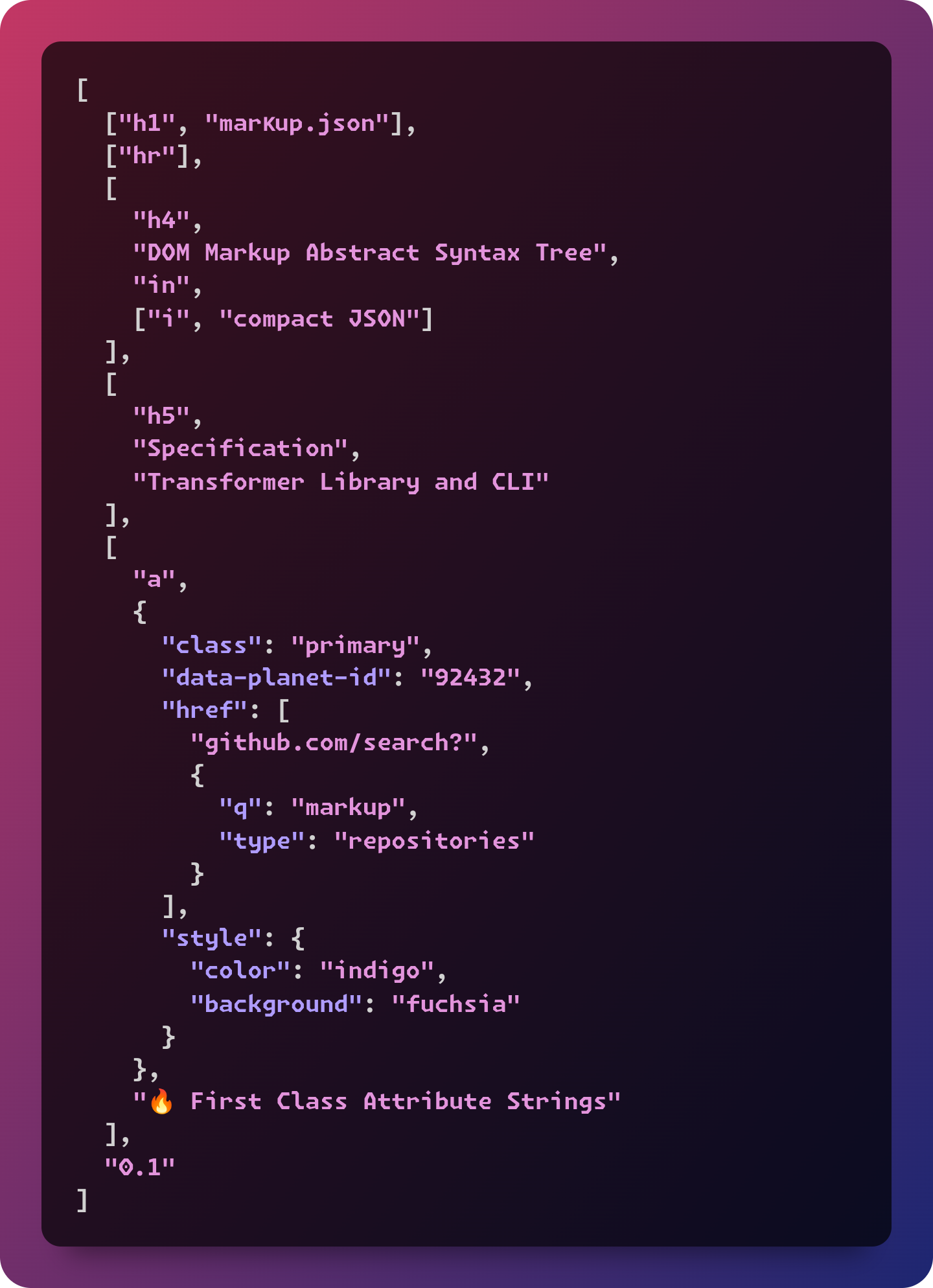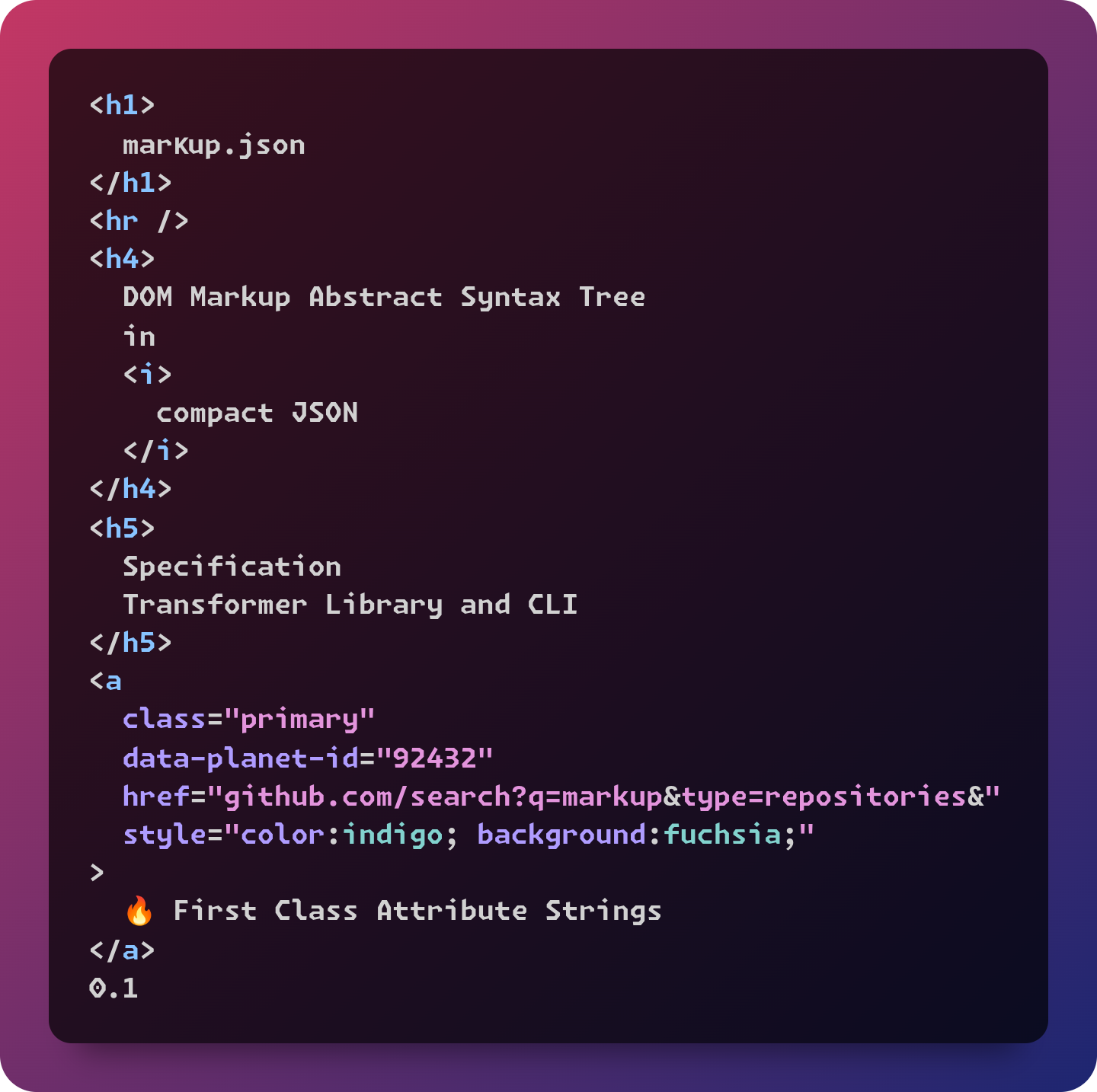markup.json is a compact, declarative JSON-based DSL for representing markup structures.
It defines an AST format and provides a CLI and library to transform it into XML-like output (HTML, SVG, RSS, etc).
markup.json is the perfect functional tool for generating any XML-like output. Use it for HTML, SVG, RSS feeds, or any structured markup:
# Generate SVG from data
curl api.example.com/chart-data | jq 'transform_to_svg' | markup > chart.svg
# Generate RSS feed
curl api.example.com/posts | jq 'transform_to_rss' | markup > feed.xml
# Generate HTML portfolio
curl api.github.com/users/metaory/repos | jq 'transform_to_portfolio' | markup > portfolio.htmlPerfect synergy with jq for functional data transformation:
# One-liner: API → Transform → Markup → Output
curl api.example.com/data | jq '.[] | select(.active) | transform_to_card' | markup > cards.htmlGenerate HTML from JSON configs without template engines:
[
"dashboard",
["h1", "User Dashboard"],
["div", {"class": "stats"},
["span", "Users: 1,234"],
["span", "Revenue: $56,789"]
]
]Convert API responses directly to HTML without intermediate steps:
curl api.example.com/users | jq 'transform_to_markup' | markup > users.htmlPerfect for generating documentation, portfolios, or reports from structured data:
- Documentation sites from JSON schemas
- Portfolio pages from project metadata
- Report generation from analytics data
Create beautiful CLI outputs that can be piped to HTML:
git log --format=json | jq 'transform_to_changelog' | markup > changelog.htmlCompose UI components as JSON and render them:
[
"app",
["header", {"component": "nav"}],
["main", {"component": "dashboard"}],
["footer", {"component": "stats"}]
]- Zero Dependencies - Pure JSON, no framework needed
- Language Agnostic - Works with any language that can generate JSON
- Version Control Friendly - JSON diffs are clean and readable
- Pipeline Integration - Perfect for Unix-style data processing
- Schema Validation - Can validate structure with JSON Schema
- Template Composition - Combine multiple JSON templates
- Dynamic Attributes - First-class support for complex attributes
- Functional Style - Pure functions, no side effects
- XML Agnostic - Generate any XML-like format (HTML, SVG, RSS, etc.)
Library:
npm install markup.json
# or
pnpm add markup.jsonCLI:
npm i -g markup.json
# or
pnpm add -g markup.json
# or with npx
npx markup.jsonLibrary:
import markup from 'markup.json'
const html = markup([
"Hello",
["h1", "World"],
["p", "This is markup.json!"]
])CLI:
echo '["Hello", ["h1", "World"], ["p", "This is markup.json!"]]' | markup🤔 The Headless HTML Generation Problem
Imagine you're in a CI environment with some JSON data and need to generate HTML. Here's how you'd solve it without markup.json:
# Option 1: Template Engine (Node.js)
npm install handlebars
node -e "
const Handlebars = require('handlebars');
const fs = require('fs');
const data = JSON.parse(fs.readFileSync('data.json'));
const template = fs.readFileSync('template.hbs', 'utf8');
const compiled = Handlebars.compile(template);
fs.writeFileSync('output.html', compiled(data));
"
# Option 2: Python Template Engine
pip install jinja2
python -c "
import json
from jinja2 import Template
with open('data.json') as f: data = json.load(f)
with open('template.html') as f: template = Template(f.read())
with open('output.html', 'w') as f: f.write(template.render(**data))
"
# Option 3: Sed/Awk (Fragile)
cat data.json | jq -r '.items[] | "\(.name): \(.description)"' | \
awk '{print "<div><h3>" $1 "</h3><p>" $2 "</p></div>"}' > output.html# One-liner: Data → Transform → HTML
cat data.json | jq 'transform_to_markup' | markup > output.htmlWhy markup.json wins:
- ✅ No dependencies - No npm/pip installs needed
- ✅ Pure functional - Single pipeline, no side effects
- ✅ Version control friendly - JSON templates are readable and diffable
- ✅ Language agnostic - Works with any tool that outputs JSON
- ✅ CI/CD ready - Perfect for automated environments
📖 Complete Example
[!Tip] Here are some real usage examples
cat .github/preview.json[
"headless",
"",
["h1", "marκup.json"],
["hr"],
[
"h4",
"DOM tree",
"representation in",
["i", "compact"],
"JSON"
],
[
"a",
{
"class": "primary",
"data-planet-id": "92432",
"href": [
"github.com/search?",
{
"q": "markup",
"type": "repositories"
}
],
"style": {
"color": "indigo",
"background": "fuchsia"
}
},
"🔥 First Class Attribute Strings"
],
"Spec",
"CLI",
"Library"
]import { readFile } from 'node:fs/promises'
import markup from 'markup.json'
const opt = { encoding: 'utf8' }
const tpl = await readFile('./tpl.json', opt)
const html = markup(JSON.parse(tpl))headless
<h1>
marκup.json
</h1>
<hr />
<h4>
DOM tree
representation in
<i>
compact
</i>
JSON
</h4>
<a
class="primary"
data-planet-id="92432"
href="github.com/search?q=markup&type=repositories&"
style="color:indigo; background:fuchsia;"
>
🔥 First Class Attribute Strings
</a>
Spec
CLI
Library📋 CLI Usage Examples
markup [-]|FILE [FILE]
Reads input from standard input or FILE
Writes to stdout or FILE
# read input and output path from args
markup [FILE] [FILE]
markup tpl.json index.html
# or with npx
npx markup.json tpl.json index.html # read input path from args
# write output to standard output
markup [FILE]
markup tpl.json
markup tpl.json > index.html
# or with npx
npx markup.json tpl.json > index.html # read input from standard input
# write output to standard output
cat FILE | markup
cat tpl.json | markup
cat tpl.json | markup > index.html
# or with npx
npx markup.json tpl.json > index.html # read from file descriptor
# write output to standard output
markup < FILE
markup < tpl.json
markup < tpl.json > index.html
# or with npx
npx markup.json < tpl.json > index.html🔧 Advanced Features & Types
type Tag = string
type primitive = string | number | boolean
type AttributeString = [string, { [k: string]: primitive }]
type Attribute =
| { [k: string]: primitive | AttributeString | object }
| primitive
type Node = [Tag, Attribute?, ...primitive[]] | string
type Markup = Node[]Attributes with Primitive values are rendered as is;
[
"top level",
"can be without tag",
[
"button",
{
"class": "primary btn",
"name": "xorg"
},
"hi",
["b", "main"],
"btn",
"here"
]
]top level
can be without tag
<button
class="primary btn"
name="xorg"
>
hi
<b> main </b>
btn here
</button>[!Tip] Attributes can come at any position after tag
[
"attributes open",
"position",
[
"button",
"hell",
{
"class": "primary btn",
"name": "xorg"
},
"OoO",
["b", "main"],
"btn",
"here"
]
]attributes open
position
<button
class="primary btn"
name="xorg"
>
hell
OoO
<b>
main
</b>
btn
here
</button>[!Tip] Repeated attributes will merge
[
"repeated",
"attributes",
[
"button",
{
"class": "primary btn",
"name": "xorg"
},
"hi",
{ "class": "shadowed", "id": "usr" },
["b", "main"],
"btn",
"here"
],
"EO"
]repeated
attributes
<button
class="shadowed"
name="xorg"
id="usr"
>
hi
<b>
main
</b>
btn
here
</button>
EOAttributes with Object values are folded
delimit key and value pairs with ;
delimit keys and values with :
[
"OBJ Values",
["h4", "Attribute with Object values"],
[
"span",
{
"class": "secondary",
"style": {
"color": "indigo",
"background": "fuchsia"
},
"anything": {
"name": "etc",
"planet": "8e81"
}
},
"Object values",
["b", "x11"],
"xorg"
]
]OBJ Values
<h4>
Attribute with Object values
</h4>
<span
class="secondary"
style="color:indigo; background:fuchsia;"
anything="name:etc; planet:8e81;"
>
Object values
<b>
x11
</b>
xorg
</span>Attributes with Object values are folded
delimit key and value pairs with &
delimit keys and values with =
[
"begin",
["h4", "Attribute with Array values"],
[
"a",
{
"class": "secondary",
"href": [
"github.com/search?",
{
"q": "markup",
"type": "repositories",
"l": "Lua"
}
]
},
"go",
["b", "find"],
"repos"
]
]begin
<h4>
Attribute with Array values
</h4>
<a
class="secondary"
href="github.com/search?q=markup&type=repositories&l=Lua&"
>
go
<b>
find
</b>
repos
</a>[
"attributes with",
"array values",
[
"img",
{
"width": "80%",
"alt": "stats",
"src": [
"github-readme-stats.vercel.app/api?",
{
"username": "metaory",
"ring_color": "5522CC",
"text_color": "44BBFF",
"border_radius": 30,
"hide_title": true,
"hide_rank": false,
"show_icons": true
}
]
}
]
]attributes with
array values
<img
width="80%"
alt="stats"
src="github-readme-stats.vercel.app/api?username=metaory&ring_color=5522CC&text_color=44BBFF&border_radius=30&hide_title=true&hide_rank=false&show_icons=true&"
/>[!Tip] Values are normalized with Unicode NFC Form Canonical Composition
"\u0041\u006d\u00e9\u006c\u0069\u0065"would be"Amélie"ref: Unicode_equivalence
[!Note] The values
"true"and"false"are not allowed on boolean attributes. To represent a false value, the attribute has to be omitted altogether.
[
"Boolean attributes",
["hr"],
[
"label",
[
"input",
{
"type": "checkbox",
"name": "cheese",
"disabled": false,
"checked": true
}
],
"Cheese"
]
]Boolean attributes
<hr />
<label>
<input
type="checkbox"
name="cheese"
checked
/>
Cheese
</label>

